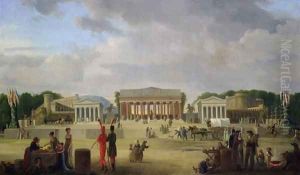Jean-Baptiste-Louis Cazin Paintings
Jean-Baptiste-Louis-Georges Cazin was a distinguished French landscape painter, ceramist, and sculptor, born on May 25, 1841, in Samer, Pas-de-Calais. Cazin's artistic journey was significantly influenced by his upbringing; his parents were well-regarded ceramicists, which naturally introduced him to the world of art and craftsmanship from an early age. He pursued his artistic education at the École Gratuite de Dessin (a precursor to the École Nationale Supérieure des Arts Décoratifs) in Paris, which laid the foundation for his versatile career. Cazin's work is characterized by a profound sensitivity to natural landscapes and a subtle, yet poignant, rendering of rural scenes and village life. His palette often employed muted, earthy tones that evoked a sense of tranquility and timeless beauty, distinguishing his work from that of his contemporaries.
Cazin's career took a significant turn when he married Marie Guillet, also an artist, with whom he shared a deep personal and professional bond. The couple moved to England during the Franco-Prussian War (1870-1871), where Cazin was exposed to the British landscape and its artistic interpretations, which further influenced his stylistic development. Upon their return to France, they settled in Equihen, on the Channel coast near Boulogne, where Cazin's focus on landscape painting intensified. His work from this period shows a remarkable depth of emotion and a mastery of light and atmosphere, which garnered him increasing recognition and acclaim.
Cazin's contributions to art were not confined to painting alone; he was also a skilled ceramist and sculptor, reflecting the influence of his early familial environment. His ceramic works, in particular, are noted for their innovative glazing techniques and the harmonious integration of sculptural forms into functional objects. Throughout his career, Cazin was honored with numerous awards, including a Gold Medal at the Paris Exposition Universelle in 1889, and he was made a Knight of the Legion of Honour, France's highest order of merit.
Jean-Baptiste-Louis Cazin's legacy is that of a versatile artist who sought to capture the essence of the natural and human landscapes around him, imbuing his works with a sense of serenity and profound emotional depth. He passed away on March 17, 1901, in Lavandou, leaving behind a body of work that continues to be celebrated for its contribution to the development of landscape painting in the late 19th and early 20th centuries.
